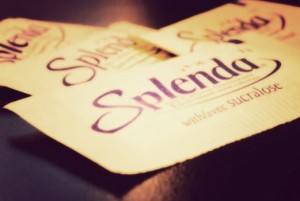 By Sayer Ji
By Sayer Ji
Contributing Writer for Wake Up World
Promoted for decades as a “safe” sugar alternative, presumably to prevent or reduce symptoms of diabetes, Splenda (sucralose) has been found to have diabetes-promoting effects in human subjects.
The artificial sweetener sucralose, which is approximately 600 times sweeter than sucrose (table sugar), and marketed under a variety of brand names, such as Splenda, Cukren, Nevella and SucraPlus, has recently been found to have diabetes-promoting effects in human test subjects, despite containing no calories and being classified as a ‘nonutritive sweetener.’
A new study published in the journal Diabetes Care, lead by researchers at the Center for Human Nutrition, Washington University School of Medicine, St. Louis, Missouri, set out to test the metabolic effects of sucralose in obese subjects who did not use nonnutritive sweeteners.
Seventeen subjects underwent a 5-hour oral glucose tolerance test on two separate occasions preceded by consuming either sucralose (experimental condition) or water (control condition) 10 min before the glucose load in a randomized crossover design.
The results were reported as follows:
Compared with the control condition, sucralose ingestion caused 1) a greater incremental increase in peak plasma glucose concentrations (4.2 ± 0.2 vs. 4.8 ± 0.3 mmol/L; P = 0.03), 2) a 20 ± 8% greater incremental increase in insulin area under the curve (AUC) (P < 0.03), 3) a 22 ± 7% greater peak insulin secretion rate (P < 0.02), 4) a 7 ± 4% decrease in insulin clearance (P = 0.04), and 5) a 23 ± 20% decrease in SI (P = 0.01).
In other words, a single dose of sucralose lead to a 0.6 mmol/L increase in plasma glucose concentrations, a 20% increase in insulin levels, a 22% greater peak insulin secretion rate, and a 7% decrease in insulin clearance, an indication of decreased insulin sensitivity.
They concluded:
These data demonstrate that sucralose affects the glycemic and insulin responses to an oral glucose load in obese people who do not normally consume NNS.
Discussion
Despite the fact that pre-approval research on sucralose found a wide range of adverse health effects in exposed animals [read article The Bitter Truth about Splenda], national and international food safety regulatory bodies, including the FDA, now consider it completely safe for daily human consumption.*
The same applies for synthetic sweeteners like aspartame, which despite its well-known link with brain damage and over 40 documented adverse health effects, is safety approved in 90 nations.
Industry influence largely accounts for the fact that synthetic chemicals like asparatame, neotame, saccharin and sucralose are being foisted onto the public as ‘safe’ non-calorie sweeteners, despite obvious research to the contrary, and the fact that stevia, the non-calorie natural alternative, has over 1500 years of documented safe use.
The American Diabetes Association (ADA), for instance, does nothing to hide its explicit partnership with McNeil Nutritionals, maker of Splenda, despite the obvious conflict of interest. On its website, the ADA describes McNeil Nutritionals as a “national strategic partner ” and lauds them as “committed to helping people and their families with diabetes by focusing on the overall nutritional needs of the diabetes community.” McNeil Nutritionals sponsors the ADA’s “Recipe of the Day,” along with a variety of educational tools and information for consumers and healthcare professionals.
Despite these cozy relationships, the research on sucralose’s adverse health effects continues to accumulate. Some of the more recent research on the chemical indicate that it may contribute to the following health and environmental problems:
- Inflammatory Bowel Disease: A researcher from UMDNJ-New Jersey Medical School, Newark NJ, proposes that sucralose may be causing a global increase in cases of IBS, including both ulcerative colitis and Crohn’s disease. [i] In an article titled “What made Canada become a country with the highest incidence of inflammatory bowel disease: could sucralose be the culprit?”, author Xiaofa Qin describes how Canada, which once had one of the lowest rates of IBS in the world, attained the highest levels after being the first country in the world to approve the use of sucralose in thousands of consumer products in 1991.[ii]
- Harms Gut Flora and Gastrointestinal Health: A 2008 study found that the administration of sucralose to rats at a dose far below the US FDA Acceptable Daily intake level resulted in: 1) a decrease in the numbers of a wide range of beneficial gut bacteria. 2) “increase in fecal pH.” 3) “enhanced expression levels of P-gp, CYP3A4, and CYP2D1, which are known to limit the bioavailability of orally administered drugs.”[iii]
- Migraines: A report was published in the journal Headache in 2006 indicating that physicians should be mindful of the possibility that sucralose can trigger migraines.[iv]
- Environmental Persistence: Like many persistent organic pollutants in the pesticide category, sucralose is exceptionally resistant to degradation, both through environmental processes (microbial degradation, hydrolysis, soil sorption) and advanced treatment processes (chlorination, ozonation, sorption to activated carbon, and UV radiation). Sucralose, after all, was discovered accidentally by pesticide researchers, and is chemically related to DDT, a chlorinated hydrocarbon. Some researchers now consider it an ideal “tracer of anthropogenic activity,” which is true also of lethal radioisotopes such as uranium 238 and plutonium 239, due to their resistance to degradation. [v] Indeed, recent research found that sucralose has a low rate of removal (11%) in drinking water tested that presently serves 28 million people.[vi]
- Environmental Toxicity: Sucralose was recently found to alter the physiological and behavioral status of crustaceans, leading researchers to warn that the chemical will likely have wider ecological consequences.[vii]
Resources:
*The FDA approves 1.1 mg/kg bodyweight, or the equivalent of 75 mg a day (about 6 packets) for a 150 lb adult.
- [i] Xiaofa Qin. Etiology of inflammatory bowel disease: A unified hypothesis. World J Gastroenterol. 2012 Apr 21 ;18(15):1708-22. PMID: 22553395
- [ii] Xiaofa Qin. What made Canada become a country with the highest incidence of inflammatory bowel disease: Could sucralose be the culprit? Can J Gastroenterol. 2011 Sep ;25(9):511. PMID: 21912763
- [iii] Mohamed B Abou-Donia, Eman M El-Masry, Ali A Abdel-Rahman, Roger E McLendon, Susan S Schiffman. Splenda alters gut microflora and increases intestinal p-glycoprotein and cytochrome p-450 in male rats. J Toxicol Environ Health A. 2008;71(21):1415-29. PMID:18800291
- [iv] Rajendrakumar M Patel, Rakesh Sarma, Edwin Grimsley. Popular sweetner sucralose as a migraine trigger. Headache. 2006 Sep;46(8):1303-4. PMID: 16942478
- [v] Lindsay Soh, Kristin A Connors, Bryan W Brooks, Julie Zimmerman. Fate of Sucralose through Environmental and Water Treatment Processes and Impact on Plant Indicator Species. Environ Sci Technol. 2011 Jan 14. [Epub ahead of print]. PMID: 21235203
- [vi] Douglas B Mawhinney, Robert B Young, Brett J Vanderford, Thomas Borch, Shane A Snyder. The Artificial Sweetener Sucralose in U.S. Drinking Water Systems. Environ Sci Technol. 2011 Aug 31. Epub 2011 Aug 31. PMID: 21879743
- [vii] Ann-Kristin Eriksson Wiklund, Magnus Breitholtz, Bengt-Erik Bengtsson, Margaretha Adolfsson-Erici. Sucralose – An ecotoxicological challenger? Chemosphere. 2012 Jan ;86(1):50-5. Epub 2011 Sep 28. PMID: 21955350
Further articles by Sayer Ji
- 7 Ways to Prevent Even Reverse Heart Disease with Nutrition
- MCT Fats Found In Coconut Oil Boost Brain Function In Only One Dose
- The Evidence-Based Healing Properties of 13 Common Fruits
- Is This Fruit Extract 10,000 Times Better Than Chemotherapy?
- How GMO Farming and Food Is Making Our Gut Flora UNFRIENDLY
- Dental Composites for Kids: Even Worse Than Mercury Amalgam?
- 13 Evidence-Based Medicinal Properties of Coconut Oil
- Five Amazing Healing Honey Facts
About the author:
 Sayer Ji is the founder and director of GreenMedInfo.com and an advisory board member at the National Health Federation, an international nonprofit, consumer-education, health-freedom organization. He co-authored the book Cancer Killers: The Cause Is The Cure, and is working on another one with Tania Melkonian titled EATomology: An Edible Philosophy of Food.
Sayer Ji is the founder and director of GreenMedInfo.com and an advisory board member at the National Health Federation, an international nonprofit, consumer-education, health-freedom organization. He co-authored the book Cancer Killers: The Cause Is The Cure, and is working on another one with Tania Melkonian titled EATomology: An Edible Philosophy of Food.

If you've ever found value in our articles, we'd greatly appreciate your support by purchasing Mindful Meditation Techniques for Kids - A Practical Guide for Adults to Empower Kids with the Gift of Inner Peace and Resilience for Life.
In the spirit of mindfulness, we encourage you to choose the paperback version. Delve into its pages away from screen glare and notifications, allowing yourself to fully immerse in the transformative practices within. The physical book enriches the learning process and serves as a tangible commitment to mindfulness, easily shared among family and friends.
Over the past few years, Wake Up World has faced significant online censorship, impacting our financial ability to stay online. Instead of soliciting donations, we're exploring win-win solutions with our readers to remain financially viable. Moving into book publishing, we hope to secure ongoing funds to continue our mission. With over 8,500 articles published in the past 13 years, we are committed to keeping our content free and accessible to everyone, without resorting to a paywall.






